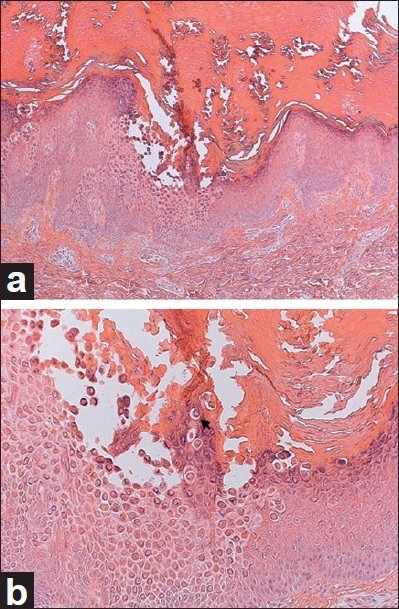Translate this page into:
Acantholytic dyskeratotic epidermal nevus
2 Department of Pathology, National Taiwan University Hospital, Taiwan
Correspondence Address:
Tsen-Fang Tsai
No.7, Chung Shan S. Rd., Taipei 100
Taiwan
| How to cite this article: Lee CH, Hsiao CH, Chiu HC, Tsai TF. Acantholytic dyskeratotic epidermal nevus. Indian J Dermatol Venereol Leprol 2011;77:253 |
Sir,
Several histological patterns of epidermal nevi exist, including acantholytic dyskeratotic epidermal nevi (ADEN), which is similar to Darier′s disease histologically. [1] ADEN on the sole had been reported only once [2] and only nine infantile cases were found in the literature. We report a one-year-old boy with ADEN on the sole, which is unusual in its location and age.
An otherwise healthy one-year-old boy was found to have a progressively enlarging linear hyperkeratotic lesion on the right sole since two months old [Figure - 1]. Plantar hyperhidrosis was also noted. There was no associated family history except his mother had psoriasis. He had been treated with calcitriol ointment, tazarotene cream, Daivobet® (calcipotriol hydrate 50 mcg/g and betamethasone dipropionate 0.5 mg/g) and excimer light under the impression of nevoid psoriasis. However, the effect was limited. No other abnormal cutaneous findings were noted. Skin biopsy was performed and showed hyperkeratosis, mild papillomatosis and focal acantholytic dyskeratosis [Figure - 2]. Polymerase chain reaction amplification and DNA sequencing of peripheral blood ATP2A2 gene were performed, but no mutation was found. Thus ADEN or segmental Darier′s disease type I was diagnosed.
 |
| Figure 1: Linear hyperkeratotic skin lesion on the right sole |
 |
| Figure 2: (a) Hyperkeratosis, mild papillomatosis and focal acantholytic dyskeratosis (H and E, ×40) (b) focal acantholytic dyskeratosis (dyskeratotic cell indicated by an arrow, H and E, ×100) |
Epidermal nevi are focal areas of abnormal epidermal development following Blaschko′s lines. Blaschko′s lines are believed to represent the lines of migration of embryonal cells proliferating from the neural crest, and are also adopted by mutated cells resulting in the linear appearance of the lesions. Post-zygotic mosaicism has been proposed to underlie the development of linear epidermal nevi. Demetree et al, reported an infant case with unilateral, linear, zosteriform epidermal nevus with acantholytic dyskeratosis in 1979. [3] It is characterized clinically by grouped, keratotic, yellow-brown papules along Blaschko′s lines and showed pathological features of acantholytic dyskeratosis. It may be aggravated by sunlight, heat and sweating. ADEN shows overlapping features with segmental Darier′s disease both clinically and histologically.
Darier′s disease is an autosomal dominant disorder characterized by palmoplantar pits, nail dystrophy and keratotic papules on the seborrheic areas (mainly upper trunk and scalp). It usually presents in the first or second decade, with a peak around puberty and is often exacerbated by sunlight. ATP2A2 mutation was found in Darier′s disease and over 100 different mutations have been reported.
More than 50 cases of segmental Darier′s disease have been reported. This disease was variably called localized, segmental, zosteriform, linear, or unilateral Darier′s disease. Compared to generalized Darier′s disease, the reported cases of segmental Darier′s disease have a later age of onset at a mean of 27 years old. [4] Reports of congenital or infantile segmental Darier′s disease are rare. The most common site of involvement of segmental Darier′s disease is trunk. [4] Type 1 lesions follow Blaschko′s lines unilaterally on a background of otherwise normal skin. However, type 2 lesions represent focal areas of increased severity on a background of generalized Darier′s disease.
Some authors consider ADEN as a variant of epidermal nevus with acantholytic dyskeratosis rather than segmental Darier′s disease due to the lack of family history and absence of other features of Darier′s disease. However, Munro et al. reported a case of ADEN with typical nail and palmar changes of Darier′s disease on the same side of the body. [5] Most importantly, Sakuntabhai et al. identified mutations of ATP2A2 gene in affected skin of ADEN, and mutations were not detected in unaffected skin or in leukocytes. [1] This study suggested that "ADEN" might be synonymous with segmental Darier′s disease. The absence of family history of Darier′s disease in ADEN cases may be explained by the frequent spontaneous mutations of ATP2A2 gene. Because no ATP2A2 mutation and no other abnormal cutaneous findings were noted, our case is more consistent with type 1 segmental Darier′s disease.
ADEN of the sole has only been reported once in an eight-year-old boy who presented the lesion since five years old. [2] The lesion consisted of multiple keratotic plaques at the base of the big toe, extending toward the calcaneal region, to the flexor surface of the fourth digit and on plantar pressure areas of his left foot. Some of the keratotic plaques showed a linear arrangement. No family history of similar skin diseases was noted. Histopathology showed acanthosis with orthokeratotic hyperkeratosis, massive suprabasal acantholysis and mild dyskeratosis.
Our case of ADEN or segmental Darier′s disease is notable for its early onset and unusual location. ADEN should be considered in cases with linear verrucous papules following Blaschko′s lines showing characteristic pathological findings of acantholytic dyskeratosis.
| 1. |
Sakuntabhai A, Dhitavat J, Burge S, Hovnanian A. Mosaicism for ATP2A2 mutations causes segmental Darier's disease. J Invest Dermatol 2000;115:1144-7.
[Google Scholar]
|
| 2. |
Micali G, Nasca MR, De Pasquale R. Linear acantholytic dyskeratotic epidermal nevus of the sole. Pediatr Dermatol 1999;16:166-8.
[Google Scholar]
|
| 3. |
Demetree JW, Lang PG, St Clair JT. Unilateral, linear, zosteriform epidermal nevus with acantholytic dyskeratosis. Arch Dermatol 1979;115:875-7.
[Google Scholar]
|
| 4. |
O'Malley MP, Haake A, Goldsmith L, Berg D. Localized Darier disease: Implications for genetic studies. Arch Dermatol 1997;133:1134-8.
[Google Scholar]
|
| 5. |
Munro CS, Cox NH. An acantholytic dyskeratotic epidermal naevus with other features of Darier's disease on the same side of the body. Br J Dermatol 1992;127:168-71.
[Google Scholar]
|
Fulltext Views
2,823
PDF downloads
2,700





